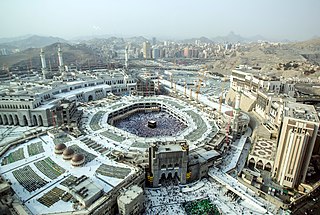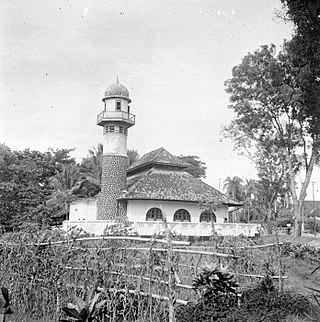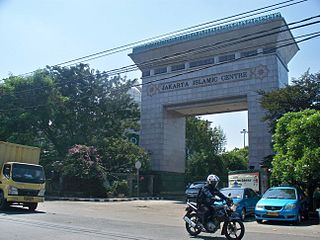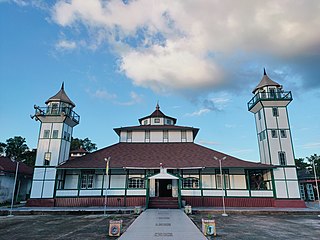
The Aqsa Mosque, also known as the Qibli Mosque or Qibli Chapel, is the main congregational mosque or prayer hall in the Al-Aqsa mosque compound in the Old City of Jerusalem. In some sources the building is also named al-Masjid al-Aqṣā, but this name primarily applies to the whole compound in which the building sits, which is itself also known as "Al-Aqsa Mosque". The wider compound is known as Al-Aqsa or Al-Aqsa mosque compound, also known as al-Ḥaram al-Sharīf.

The Prophet's Mosque is the second mosque built by the Islamic prophet Muhammad in Medina, after that of Quba, as well as the second largest mosque and holiest site in Islam, after the Masjid al-Haram in Mecca, in the Saudi region of the Hejaz. The mosque is located at the heart of Medina, and is a major site of pilgrimage that falls under the purview of the Custodian of the Two Holy Mosques.

Istiqlal Mosque in Jakarta, Indonesia is the largest mosque in Southeast Asia and the ninth largest mosque in the world in terms of worshipper capacity. Built to commemorate Indonesian independence, this national mosque of Indonesia was named "Istiqlal", an Arabic word for "independence". The mosque was opened to the public on 22 February 1978. Within Jakarta, the mosque is positioned next to Merdeka Square, the Jakarta Cathedral (Catholic), and also of the Immanuel Church (Reformed).

A congregational mosque or Friday mosque, or sometimes great mosque or grand mosque, is a mosque for hosting the Friday noon prayers known as jumu'ah. It can also host the Eid prayers in situations when there is no musalla or eidgah available nearby to host the prayers. In early Islamic history, the number of congregational mosques in one city was strictly limited. As cities and populations grew over time, it became more common for many mosques to host Friday prayers in the same area.

Tambora is a district (kecamatan) of West Jakarta Administrative City, Indonesia. Tambora District is bounded by a railway to the west and to the north, Kali Krukut - Kali Besar canal to the east, and Duri Selatan Road to the south.

The Ganting Grand Mosque is a Sunni mosque located in Ganting, Padang, West Sumatra, Indonesia. Construction began in 1805, making it the oldest in Padang and one of the oldest in Indonesia. It is a Cultural Property of Indonesia.

Masjid al-Haram, also known as the Sacred Mosque or the Great Mosque of Mecca, is considered to be the most significant mosque in Islam. It encloses the vicinity of the Kaaba in Mecca, in the Mecca Province of Saudi Arabia. It is among the pilgrimage sites associated with the Hajj, which every Muslim must perform at least once in their lives if able. It is also the main site for the performance of ʿUmrah, the lesser pilgrimage that can be undertaken any time of the year. The rites of both pilgrimages include circumambulating the Kaaba within the mosque. The Great Mosque includes other important significant sites, such as the Black Stone, the Zamzam Well, Maqam Ibrahim, and the hills of Safa and Marwa.

Angke Mosque, officially known as Masjid Jami Angke or Masjid Al-Anwar, located at Tambora, Jakarta, Indonesia. It is one of the oldest mosques in Jakarta. Well-maintained and retaining its original form, the mosque has been called by the historian Denys Lombard as 'une des plus élégantes de la vieille villa'. The history of the mosque reflects the multiethnic and multilayered origin of colonial Jakarta.

Masjid Jami' Al-Makmur Cikini is located on Jalan Raden Saleh Raya in Cikini, Central Jakarta, and is one of the oldest mosques in the locality. It was formerly known as Tjikini Mosque.

Wapauwe Old Mosque is a historic mosque in Kaitetu village, located in the Wawane Mountains on the north part of cape Keitetu, Maluku, Indonesia. Established in 1414, it is the oldest mosque in the Moluccas and possibly the oldest mosque in Indonesia which has been maintained in its original state.

The Great Mosque of Malang is a mosque located in Malang, East Java, Indonesia. The mosque was built in 1890 and completed in 1903. The mosque is square-shaped, constructed with steel, and has a tajug on top. The original building is still maintained today.

Jamik Sungai Jambu Mosque is one of the oldest mosques in Indonesia located in Jorong Sungai River, Sungai Jambu Nagari, Pariangan District, Tanah Datar Regency, West Sumatra. The mosque was built in 1918 at the foot of Mount Marapi, and during its development it has experienced a number of improvements both in terms of outlook and management. The mosque had ranked first for several times including in 2012, in the assessment of environmentally-oriented mosques for the provincial level which is conducted by the Indonesian Mosque Council.

Jakarta Islamic Centre (JIC) is a center for Islamic studies and research in Koja, Jakarta, Indonesia. Activities of JIC include ZISWAF empowerment, education, socio-economic activities, regular recitations, Tabligh Akbar, and celebrations of Islamic holidays.
The Al-Anshor Mosque is arguably the oldest mosque in Jakarta, Indonesia. It is located at Pekojan, Tambora, Jakarta and was built in 1648.

Grand Mosque of Makassar is a mosque located in Makassar, Indonesia, and the main mosque of South Sulawesi Province. The construction begun in 1948 and completed in 1949. Since then the mosque underwent a renovation from 1999 to 2005. The mosque can accommodate up to 10,000 worshipers, making it one of the largest mosques in Southeast Asia.
The Al-Mansur Mosque is one of the oldest mosques in Jakarta, Indonesia. The mosque is located at Jembatan Lima, Tambora, Jakarta. The mosque is one of the listed cultural heritage of Jakarta. The mosque is named after Kh. Mohammad Mansur who is familiarly called Guru Mansur- a Betawi figure known for his fight against Dutch colonial rules.

Masjid Jami Kampung Baru Inpak, also known as Masjid Kampung Baru or Bandengan Mosque, is one of the oldest mosques in Jakarta, Indonesia. It is located at Jalan Bandengan Selatan, Pekojan, Tambora, Jakarta, close to Masjid Al-Anshor. It is one of the mosques that was built by Muslim merchants from India who used to travel to and live in Batavia. The mosque has been designated as cultural heritage by the provincial government of DKI Jakarta.

Jami Mosque of Sintang also known as Sultan Nata Mosque is a mosque located in Sintang, West Kalimantan, Indonesia. The mosque is located within the complex of Istana al-Mukarrammah, the main palace of the Sultanate of Sintang, a kingdom in Sintang which existed since the 13th-century.
The Lautze 2 Mosque is a mosque in Bandung, West Java, Indonesia.


























